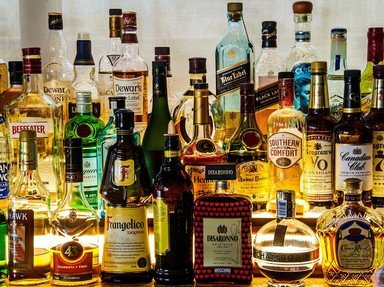Quiz Answer Key and Fun Facts
1. Before bourbon stole the spotlight, and before Prohibition, rye whiskey was America's drink, expanding in popularity after the Revolutionary War made rum hard to acquire. Under U.S. law, rye must be made in the United States, and must use a mash bill (the mix of grains distilled into the whiskey) that is 51% or more rye. One style of rye that emphasizes its historical roots, exemplified by Old Overholt and Dad's Hat, is named for the river valley where rye whiskey originates - and where the Whiskey Rebellion was fought. What river?
2. Bourbon whiskey must use a mash bill that includes 51% or more corn. Most brands use around 30% rye as a secondary grain; a few, such as Maker's Mark, use wheat instead. But what if you used corn on top of corn to make a whiskey? Corn whiskey is a separate category that must use 80% or more corn in its mash bill. The most famous corn whiskey is Mellow Corn, an inexpensive offering produced by Heaven Hill. What color is Mellow Corn whiskey?
3. Rye, corn - why not wheat? Wheat whiskeys are comparatively rarer than other whiskeys, since wheat has a comparatively milder flavor. That's not to say they don't exist. Which wheat whiskey, based in Bardstown, Kentucky, features a bundle of wheat on its label?
4. Of course, America is not the only producer of American whiskey! One of the bestselling whiskies worldwide is this brand, known for its fruity flavors and signature drawstring bags. Name the whisky.
5. A rapidly developing segment of North American whiskey is Mexican whisky (which, like Canada, chooses to drop the "e"). One such brand is Abasolo, a dark whisky distilled from cacahuazintle corn. In addition to using an "heirloom" cultivar, Abasolo process the corn using alkaline water. This process is also performed to prepare corn for making tortillas. What is it called?
6. Who's afraid of a little malt? One of the whiskey styles exploding in popular are American malt whiskeys. Just like its better-known competitors in Scotland and Japan, single malt whiskey made in America MUST use a mash bill that's 100% what grain?
7. While Tennessee whiskey is a subcategory of bourbon, very little bourbon qualifies as Tennessee whiskey. The two big manufacturers of Tennessee whiskey, George Dickell and Jack Daniels, don't even label their flagships "bourbon," although they qualify. Besides being made in Tennessee, Tennessee whiskey must also employ the so-called Lincoln County process. Before aging, it must be passed through what?
8. Tennessee's not the only state that's distinguished its whiskeys. This state, home of three presidents and two Six Flags parks, has a state Whiskey Association that certifies select whiskeys produced entirely within its borders. Popular brands from the state include Balcones Distilling and Garrison Brothers Distilling. What is the state?
9. Easton's Bible Dictionary, written in Scotland, says of this grain, "In this country, it is used only for feeding birds." Not so in America! Koval has produced one of the more unusual American whiskeys, in a bid to stand out in the crowded craft space, using only this grain. The company claims to be the first to put it to whiskey-making purposes. What grain am I speaking of?
10. Finally, we should say a word about some of the popular whiskey-based liqueurs on the market. Notice I don't call them "whiskey" per se. Fireball, for example, is labelled "Cinnamon Whisky," because it is not just "whisky" but a flavored beverage containing whisky. If you're confused, let me give you a point of conversion: what is the minimum PROOF a whiskey can be bottled at, according to the TTB? Add 14 to the proof of Fireball Cinnamon Whisky, and you'll have your answer.
Source: Author
etymonlego
This quiz was reviewed by FunTrivia editor
Bruyere before going online.
Any errors found in FunTrivia content are routinely corrected through our feedback system.
